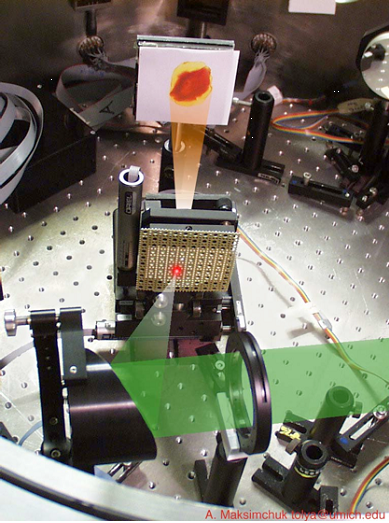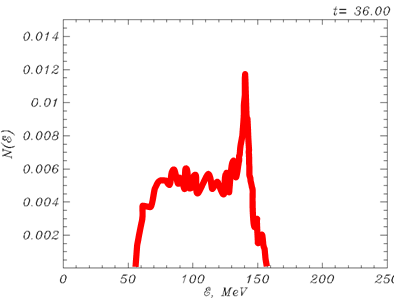When an intense laser pulse interacts with a thin film target it instantaneously turns a thin front layer of the film into a dense plasma. In this layer, where laser’s and plasma’s frequencies are equal, the laser pulse is strongly absorbed, terminating its propagation into denser plasma region. This layer is called the plasma’s critical surface. Interaction of the intense laser light with plasma at this surface produces highly energetic electrons with multi-MeV energies which are emitted forward and propagate through the foil. Several processes can be responsible for generation of high-energy electrons such as resonant absorption, ponderomotive acceleration due to v x B force, stochastic heating, “vacuum heating”, etc. Hot electrons propagating all the way through a thin film can establish a very strong electrostatic field at the back of the target which can accelerate protons with maximum energy of tens of MeV and ion beams with energy of hundreds MeV [1-4]. University of Michigan researchers were among the first to observe this effect. Fig. 1 shows a typical experimental setup for ion acceleration.

Beams of highly energetic ions have a wide array of applications such as a compact sources of radioactive isotopes [5-7] and ion injector sources [8]. Beams of energetic proton can be used to generate quasi-homogeneous warm dense matter by isochoric heating of solid density foils [9] or can be used as a radiography source to detect and study the evolution of electric fields in laser-matter interaction [10]. The possibilities have been discussed for using beams of laser driven ions for hadron radiation therapy [11], fast ignitor research [12,13] and even for production of elementary particles [14,7].
Most proton beam applications require controllable quasi-monoenergetic beams that are orders of magnitude above current laser accelerated proton energies. For example, proton radiation therapy, which is superior to electron or x-ray radiation therapies, is currently performed with large accelerators and requires proton energies of about 200 MeV. At present, protons from laser-plasma interaction are produced from targets orders of magnitude thicker than the plasma skin depth in the target normal sheath acceleration (TNSA) regime [15]. This generates proton beams with energy up to several to tens of MeV but with an energy spectrum exhibiting an exponential decay of the number of the accelerated protons followed by a cutoff.
With HERCULES laser we will be able to explore a new regime of ion acceleration using interaction of ultra-relativistic and ultra-clean laser pulses with ultra-thin membranes to achieve controllable quasi-monoenergetic beams of protons with energy above 100 MeV. We anticipate that this research will result in the development of the efficient high-repetition rate table-top proton source, which can be of interest for proton radiation therapy.
Directed Coulomb Explosion Regime of Ion Acceleration
High laser contrast enables the direct interaction of an intense laser pulse with solid targets, as opposed to the lower density interaction that occurs when the target is pre-ionized by Amplified Spontaneous Emission. When a high contrast, intense laser pulse (~1022 Wcm–2) interacts with a sub-micron thick foil, it ionizes the target within a few femtoseconds maintaining the integrity of the overdense plasma. For very thin targets, the ponderomotive force of the laser expels electrons from a region having a transverse dimension on the order of the laser spot size- resulting in a region of net positive charge. If the energy of the accelerated electrons is large enough to overcome the Coulomb attraction of the positively charged ion region, then the electrons will not return, resulting in ion acceleration in the “Coulomb explosion” regime [16,17].


Fig. 2: 2D Particle In-Cell simulation results (left) ion density distribution. (right) Spectrum of protons accelerated by a (f/D=1.5) 500 TW Gaussian laser pulse interacting with a 0.1 micron thick aluminum foil with 0.05 micron thick hydrogen second layer.
For double-layer (high Z/low Z) targets having thickness up to several hundred nanometers, these interactions not only expel electrons from the irradiated area but also accelerate the remaining heavy ion core, which begins to move in the direction of laser propagation. The moving heavy ion layer experiences a Coulomb Explosion due to the excess of positive charge and expands predominantly in the direction of the laser pulse propagation. This expanding cloud generates a moving longitudinal electric field due to charge separation, which consequently provides very directional acceleration for low Z ions to high energies. We refer to this mode of ion acceleration as the Directed Coulomb Explosion (DCE) regime. Simulations predict that in this regime much higher energy and more efficient proton beams are possible than any observed to date [18].
We have simulated the direct interaction of a 500 TW (peak intensity of 3×1022 Wcm–2) 30 fs Gaussian laser pulse with a double layer aluminum-hydrogen foil in the DCE regime. Fig. 2 shows ion density distribution. The spectrum of protons (Fig. 3) has quasi-monoenergetic features and is peaked at 140 MeV, with a FWHM of 10 MeV. The width of the peak is mainly due to the Coulomb repulsion of protons and can be varied by changing the amount of hydrogen, giving additional control.
Plasma Mirrors and Contrast
Light contamination that arrives before the main pulse from sources such as amplified spontaneous emission (ASE) or higher order dispersion is also focused to high intensities. The ratio between this prepulse and the main pulse is known as the laser contrast. For high intensity experiments, this prepulse is also focused and without removal can cause preplasma formation which can significantly alter the density profile, or even destroy targets before the main pulse arrives. Proton acceleration from the TNSA mechanism is suppressed for large preplasma scale lengths [19]. Several novel acceleration mechanisms require targets with thickness of tens of nanometers, which can be destroyed by such prepulse. The High Harmonic Generation mechanism also requires a sharp density gradient, necessitating the need for prepulse removal.
While the HERCULES laser exhibits a high amount of laser contrast of 10-11, for very high intensity experiments with 1021 – 1022 Wcm-2, it is insufficient to prevent preplasma formation. To substantially increase the contrast further, a type of relativistic shutter known as “plasma mirrors” are employed [20]. The plasma mirror is simply a piece of optical quality glass with an anti-reflective coating (Fig. 3). The laser pulse is focused such that the main pulse is just above the damage threshold of the plasma mirror while the prepulse is below. On the leading edge of the main pulse, the optic will form a plasma and reflect the main pulse, and since the laser pulse duration is tens of femtoseconds, the plasma has no time to expand and thus the plasma mirror has the same wavefront as the original optic. In high intensity experiments, two plasma mirrors are used to increase the contrast by 5 orders of magnitude with a 50% energy loss of the main pulse, so that experiments can be performed at an intensity of >1021 Wcm-2 with a contrast of 10-15.

Ion Acceleration with Hercules Laser
With the high levels of contrast achievable with HERCULES, high intensity experiments may be performed with targets that can have nanometer thicknesses. For targets that are significantly thinner than the laser wavelength, CUOS researchers have been able to demonstrate high energy ion acceleration with proton energies up to 20 MeV and carbon beams with energies up to 140 MeV [21] with a laser pulse possessing energy of less than 1.5 Joules (Fig. 4).

Fig. 4. Carbon energy spectra for (a) right-hand circular and (b) linear polarized laser pulse interaction for 30 nm SiN targets. Detector background levels are shown for comparison. Raw spectra are shown for (c) circular and (d) linear polarization, with the high energy carbon peak denoted by the red circle.
The TNSA mechanism produces a Boltzmann-like, broad energy spread in the ion spectra which is difficult to overcome. CUOS researchers have shown that even in novel schemes such as radiation pressure acceleration finite spot effects can cause broad energy spread electron beams that will accelerate ions at different energies. Producing a narrow energy spread has long been a goal of laser based ion acceleration for many applications, and most work that has been done relies on complex targets or by energy selection of the ion beam [22,23]. At HERCULES, an entirely new mechanism of ion energy spectral shaping has been demonstrated that exploits the properties of the femtosecond laser for use to shape the density profile of the target. By sending in a weak prepulse tens of picoseconds prior to the main pulse, we can instigate a weak TNSA interaction. When the main pulse arrives, only the lightest particles have had time to expand, in this case the protons and carbons. The heavier ions in the main target have moved negligibly so that the target density profile is well maintained, however, the light ions have moved apart so much that they no longer feel the influence of each other. When the main pulse interacts in a TNSA scheme, all of the light ions experience the same accelerating field and are thus quasi-monoenergetic [24]. This method of spectral control is well suited for high repetition rate experiments that rely on simple, easy to align targets.
Ion Production using the Lambda-cubed Laser
Using high-contrast, 3 mJ pulses from the femtosecond 0.5 kHz lamda-cubed laser interacting with a bulk glass target, ions are accelerated backward (toward vacuum) along the normal direction. Protons with energies > 265 keV are recorded in a well-collimated beam with an opening angle of about 16° FWHM. Spectral measurements indicate that the central flux for protons exceeding 90 keV is 8.5×1011s-1sr-1and for those exceeding 0.5 MeV, the peak is collimated to 3.2×109s–1sr-1.Such a proton beam may be suitable for injection into external accelerators, for example. The same process could be used to produce energetic deuterons through laser interaction with a deuterated target, and subsequently generate significant fluxes of neutrons via fusion reactions [25,26].
References
- E. Clark, K. Krushelnick, J. R. Davies, M. Zepf, M. Tatarakis, F. N. Beg, A. Machacek, P. A. Norreys, M. I. K. Santala, I. Watts, and A. E. Dangor, “Measurements of energetic proton transport through magnetized plasma from intense laser interactions with solids,” Phys. Rev. Lett. 84, 670 (2000).
- A. Maksimchuk, S. Gu, K. Flippo, D. Umstadter and V. Yu. Bychenkov, “Forward ion acceleration in thin films driven by a high intensity laser,” Phys. Rev. Lett. 84, 4108 (2000).
- R. Snavely, M. H. Key, S. P. Hatchett, T. E. Cowan, M. Roth, T. W. Phillips, M. A. Stoyer, E. A. Henry, T. C. Sangster, M. S. Singh, S. C. Wilks, A. MacKinnon, A. Offenberger, D. M. Pennington, K. Yasuike, A. B. Langdon, B. F. Lasinski, J. Johnson, M. D. Perry, E. M. Campbell, “Intense high-energy proton beams from petawatt-laser irradiation of solids,” Phys. Rev. Lett. 85, 2945 (2000).
- E. L. Clark, K. Krushelnick, M. Zepf, F. N. Beg, A. Machacek, P. A. Norreys, M. I. K. Santala, M. Tatarakis, I. Watts and A. E. Dangor, “Energetic heavy ion and proton generation from ultra-intense laser-plasma interactions with solids,” Phys. Rev. Lett. 85, 1654 (2000).
- M. I. K. Santala, K. W. D. Ledingham, M. Zepf, R. Allott, F. N. Beg, E. L. Clark, R. J. Clarke, A. E. Dangor, K. Krushelnick, A. C. Machacek, T. McCanny, P. A. Norreys, I. Spencer, M. Tatarakis, and I. Watts, “Production of radioactive nuclides by energetic protons generated from intense laser-plasma interactions” Appl. Phys. Lett. 78, 19 (2001).
- K. Nemoto, A. Maksimchuk, S. Banerjee, K. Flippo, G. Mourou, D. Umstadter and V. Bychenkov, “Laser-triggered ion acceleration and table top isotope production,” Appl. Phys. Lett. 78, 595 (2001).
- A. Maksimchuk, K. Flippo, H. Krause, G. Mourou, K. Nemoto, D. Shultz, D. Umstadter, R. Vane, V. Yu. Bychenkov, G. I. Dudnikova, V. F. Kovalev, K. Mima, V. N. Novikov, Y. Sentoku, and S. V. Tolokonnikov, “High-energy ion generation by short laser pulses,” Plasma Physics Reports 30, 473 (2004).
- K. Krushelnick, E. Clark, R. Allott, F. N. Beg, C. Danson, A. Machacek, V. Malka, Z. Najmudin, D. Neely, P. A. Norreys, M. Salvati, M. I. K. Santala, M. Tatarakis, I. Watts, M. Zepf and A. E. Dangor, “Ultra high intensity laser-produced plasmas as a compact heavy ion injection source,” IEEE Transactions in Plasma Science 28, 1184 (2000).
- P. K. Patel, A. J. Mackinnon, M. H. Key, T. E. Cowan, M. E. Foord, M. Allen, D. F. Price, H. Ruhl, P. T. Springer, and R. Stephens, “Isochoric heating of solid-density matter with an ultrafast proton beam,” Phys. Rev. Lett. 91 125004 (2003).
- M. Borghesi, D. H. Campbell, A. Schiavi, M. G. Haines, O. Willi, A. Mackinnon, P. Patel, L. A. Gizzi, M. Galimberti, R. J. Clarke, F. Pegoraro, H. Ruhl, S. V. Bulanov, “Electric field detection in laser-plasma interaction experiments via the proton imaging technique,” Phys. Plasmas 9, 2214 (2002).
- S. V. Bulanov and V. S. Khoroshkov, “Feasibility of using laser ion accelerators in proton therapy,” Plasma Physics Reports 28, 453 (2002).
- M. Roth, T. E. Cowan, M. H. Key, S. P. Hatchett, C. Brown, W. Fountain, J. Johnson, D. M. Pennington, R. A. Snavely, S. C. Wilks, K. Yasuike, H. Ruhl, F. Pegoraro, S. V. Bulanov, E. M. Campbell, M. D. Perry, and H. Powell, “Fast ignition by intense laser-accelerated proton beams,” Phys. Rev. Lett. 86, 436 (2001).
- V.Yu. Bychenkov, W. Rozmus, A. Maksimchuk, D. Umstadter and C. E. Capjack “Fast ignitor concept with light ions,” Plasma Phys. Report 27, 1017 (2001).
- V. Yu. Bychenkov, Y. Sentoku, S. V. Bulanov, K. Mima, G. Mourou, and S. V. Tolokonnikov, “Pion production under the action of intense ultrashort laser pulse on a solid target,” JETP Letters 74, 2001, 586-9 (2001).
- S. C. Wilks, A. B. Langdon, T. E. Cowan, M. Roth, M. Singh, S. Hatchett, M. H. Key, D. Pennington, A. MacKinnon, R. A. Snavely, “Energetic proton generation in ultra-intense laser-solid interactions,” Phys. Plasmas 8, 452 (2001).
- V. Y. Bychenkov and V. F. Kovalev “On the maximum energy of ions in a disintegrating ultra-thin foil irradiated by a high power ultra-shot laser pulse” Quantum Electronics 35, 1143 (2005).
- L. Yin, B. J. Albright, B. M. Hegelich, J. C. Fernandes, “GeV laser ion acceleration from ultra-hin targets: the laser breakout afterburner” Laser and Particle Beams 24 291 (2006).
- S. S. Bulanov, A. Brantov, V. Yu. Bychenkov, V. Chvykov, G. Kalinchenko, T. Matsuoka, P. Rousseau, S. Reed, V. Yanovsky, K. Krushelnick, D. W. Litzenberg and A. Maksimchuk, “Accelerating protons to therapeutic energies with ultra-intense ultra-clean and ultra-short laser pulses,” Med. Phys. 35, 1770 (2008).
- M. Kaluza, J. Schreiber, M. I. K. Santala, G. D. Tsakiris, K. Eidmann, J. Meyer-ter-Vehn, and K. J. Witte, “Influence of the Laser Prepulse on Proton Acceleration in Thin-Foil Experiments” Physical Review Letters 93 045003 (2004).
- P. Gibbon, “Cleaner petawatts with plasma optics” Nature Physics 3 369 (2007).
- F. Dollar, C. Zulick, A. G. R. Thomas, V. Chvykov, J. Davis, G. Kalinchenko, T. Matsuoka, C. McGuffey, G. M. Petrov, L. Willingale, V. Yanovsky, A. Maksimchuk, and K. Krushelnick, “Finite spot effects on radiation pressure acceleration from intense high-contrast laser interactions with thin targets,” Physical Review Letters 108, 175005 (2012).
- B. M. Hegelich, et al., Nature, 439, 441 (2006).
- T. Toncian, et al., Science, 312, 410 (2006).
- F. Dollar, T. Matsuoka, G. M. Petrov, A. G. R. Thomas, S. S. Bulanov, V. Chvykov, J. Davis, G. Kalinchenko, C. McGuffey, L. Willingale, V. Yanovsky, A. Maksimchuk, and K. Krushelnick, “Control of energy spread and dark current in proton and ion beams generated in high-contrast laser solid interactions,” Phys. Rev. Lett. 107, 065003 (2011).
- B. X Hou, J. Nees, J. Easter, J. Davis, G. Petrov, A. Thomas, and K. Krushelnick, “MeV proton beams generated by 3 mJ ultrafast laser pulses at 0.5 kHz”, Applied Physics Letters 95, 101503 (2009).
- B. Hou, J. A. Nees, H. Zhaohan, G. Petrov, J. Davis, J. H. Easter, A. G. R. Thomas, and K. M. Krushelnick, “ Laser-ion acceleration through controlled surface contamination,” Physics of Plasmas, 18 040702 (2011).
